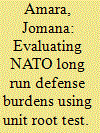|
|
|
Sort Order |
|
|
|
Items / Page
|
|
|
|
|
|
|
| Srl | Item |
| 1 |
ID:
182554


|
|
|
|
|
| Summary/Abstract |
This paper presents new evidence on the effects of neighbors and allies on defense burdens using a spatial econometrics model with panel data on 36 countries in Europe collected over 19 years. Apart from the conventional spatial matrices of geographical neighbors, we develop special political vicinity matrices based on arms transfers, which reveal political closeness among countries, and solve the problems associated with endogenous weight matrices by using a QMLE approach. The regression results demonstrate that the defense burden is positively and spatially correlated among geographical neighbors. The use of political vicinity matrices reveals a negative effect of allied relations on defense burdens, which supports the free-riding theory in alliances for setting a defense budget. With composite matrices, the intimidation effect induced by geographical approaches is dominated by the free-riding actions of allies, and the effect becomes more pronounced over time.
|
|
|
|
|
|
|
|
|
|
|
|
|
|
|
|
| 2 |
ID:
079648


|
|
|
|
|
| Publication |
2007.
|
| Summary/Abstract |
This study evaluates NATO long run defense burdens by analyzing the time-series properties of burden measures, namely growth of defense spending, defense share in national output, defense share in government spending, defense spending per capita, and defense share in total NATO spending for the time period 1949-2002. The study also compares the effect of using government Purchasing Power Parity conversion factors and Market Exchange Rates for defense share in total NATO expenditure conversions and the implications of NATO expansion in light of the defense burden measures of the newer NATO members.
|
|
|
|
|
|
|
|
|
|
|
|
|
|
|
|
| 3 |
ID:
156658


|
|
|
|
|
| Summary/Abstract |
Using the latest spatial econometric techniques and data pertaining to 144 countries over the period 1993–2007, this article tests and compares four frequently used spatial econometric models and eight matrices describing the mutual relationships among the countries, all within a common framework, which helps clarify the impact of neighboring countries on military expenditures. Furthermore, it utilizes two different data sources. Due to this setup, it provides one of the most thorough spatial analyses of military expenditures so far. Furthermore, it confirms but also challenges the results of several previous studies. Military spending measured as a ratio of GDP in one country indeed depends primarily on the spending of other countries, but in a limited number of cases, it also depends on control variables that can be observed in other countries, among which are the level of GDP, the occurrence of international wars, and the political regime. The most likely specification of the matrix describing the relationships among countries is the first-order binary contiguity matrix based on land or maritime borders, extended to include two-sided relationships among the five countries that are permanent members of the UN Security Council and one-sided relationships to all other countries. Finally, cross-sectional approaches are rejected in favor of dynamic spatial panel data approaches due to their controls for habit persistence, country, and time-period fixed effects.
|
|
|
|
|
|
|
|
|
|
|
|
|
|
|
|
|
|
|
|
|